Introduction
In an era where operational efficiency is paramount, the strategic deployment of Robotic Process Automation (RPA) offers a pathway to transformative gains. This article delves into the multifaceted dimensions of leveraging RPA, beginning with a comprehensive understanding of its capabilities and limitations. From identifying suitable automation opportunities to mapping out precise workflows, the journey to efficient RPA integration is meticulously outlined.
Additionally, the importance of a scalable roadmap and the establishment of a Center of Excellence for governance underscores the need for structured and strategic implementation. Finally, the focus on measuring results and documenting lessons learned ensures that RPA initiatives not only achieve immediate gains but also contribute to long-term organizational resilience and innovation. Discover how to harness the full potential of RPA to drive productivity, enhance accuracy, and achieve sustainable operational excellence.
Understand RPA Capabilities and Limitations
To harness the true potential of Robotic Process Automation (RPA), it is crucial to comprehend its scope thoroughly. RPA has proven to be transformative in streamlining repetitive tasks, enhancing productivity, and improving accuracy. For instance, a study by IoT Analytics highlights that successful digital transformation initiatives involve steps like digitization, digitalization, and eventually full-scale digital transformation, which RPA can significantly contribute to. Nevertheless, not every procedure is appropriate for mechanization. Processes requiring human judgment, creativity, or complex decision-making should remain within the human domain. ‘This distinction is important, as emphasized by the ongoing development in intelligent systems ranging from AI-augmented to cognitive systems, which still necessitate human oversight and intervention.’. As industry leaders, such as those in the research article “Industry 4.0 check-in: 5 learnings from ongoing digital transformation initiatives,” have demonstrated, identifying the right processes for RPA can lead to higher operational efficiency and cost savings, while misapplication can lead to inefficiencies and resistance.
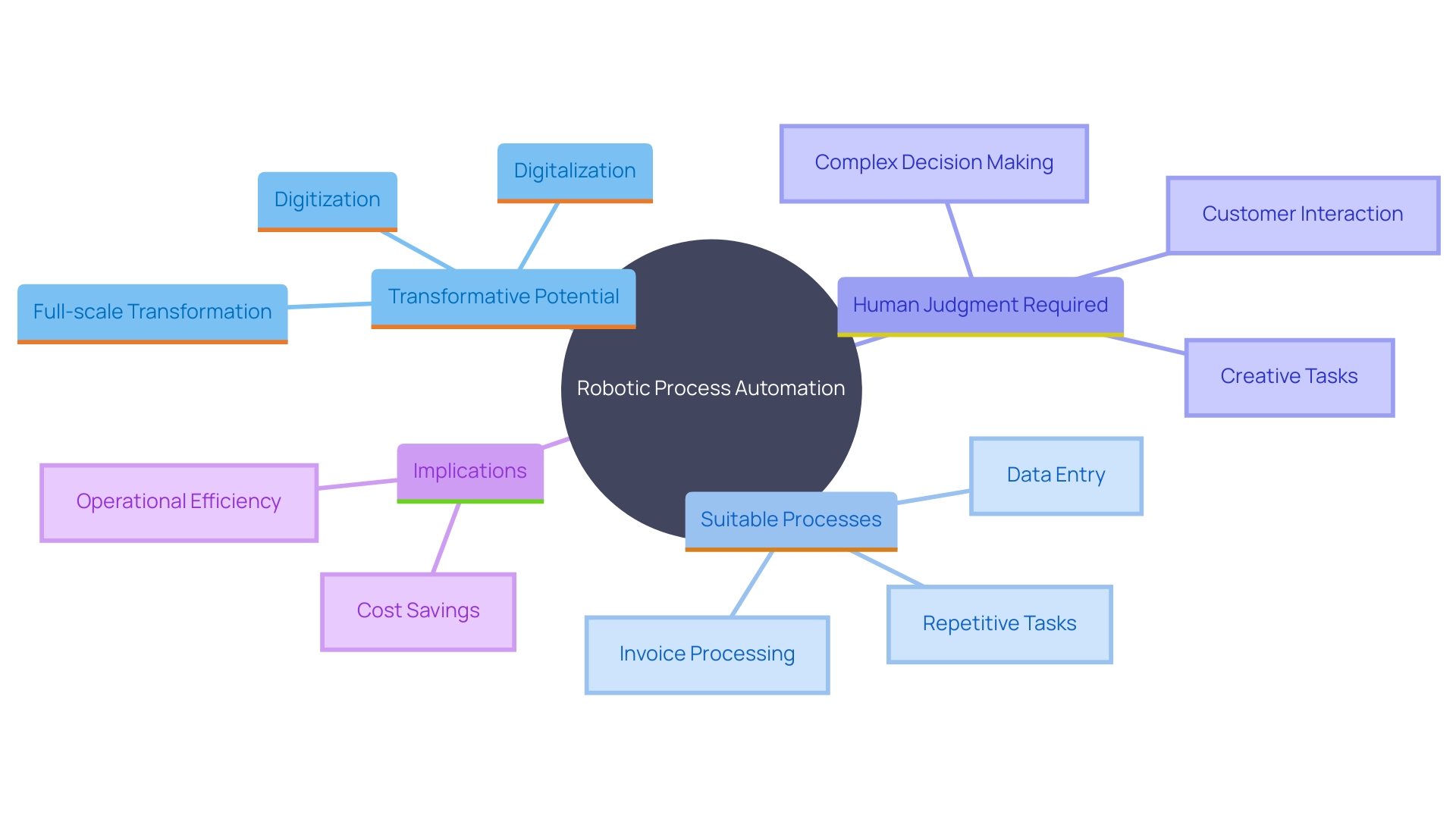
Identify Potential RPA Opportunities
Begin by conducting a comprehensive analysis of your existing workflows to identify areas where Robotic Process Automation (RPA) can be effectively implemented. Concentrate on tasks that are high in volume and repetitive, which take up considerable time and resources, as these are ideal prospects for mechanization. Engaging with teams across departments can help uncover pain points and inefficiencies that RPA can address, ensuring that the automation initiatives align with overall business objectives.
An effective RPA strategy should follow a structured approach encompassing digitization, modernization, and transformation. Digitization involves transforming physical data and documents into an electronic format, which serves as the foundation for further technological enhancements. Digitalization utilizes this digitized data to change procedures, organizational structures, and decision-making frameworks, enhancing data capture, analysis, and information dissemination. Ultimately, technological transformation fundamentally alters how an organization functions, positioning technology at the core of comprehensive execution. This transformation allows human employees to focus on providing high-value expertise rather than getting bogged down by repetitive tasks.
For instance, Surrey County Council, which serves 1.2 million residents, successfully implemented RPA to streamline various services, from transport and highway management to social care and education. This initiative not only improved operational efficiency but also enhanced the overall experience for both employees and residents.
According to a report from Bain & Company, organizations that adopt a comprehensive approach to automation can achieve efficiency gains of 30% or more. This underscores the importance of a well-planned RPA strategy that aligns with your business goals. By converting and modernizing methods, you pave the way for a technological transformation that can significantly enhance productivity and create additional value for your organization, partners, and customers.
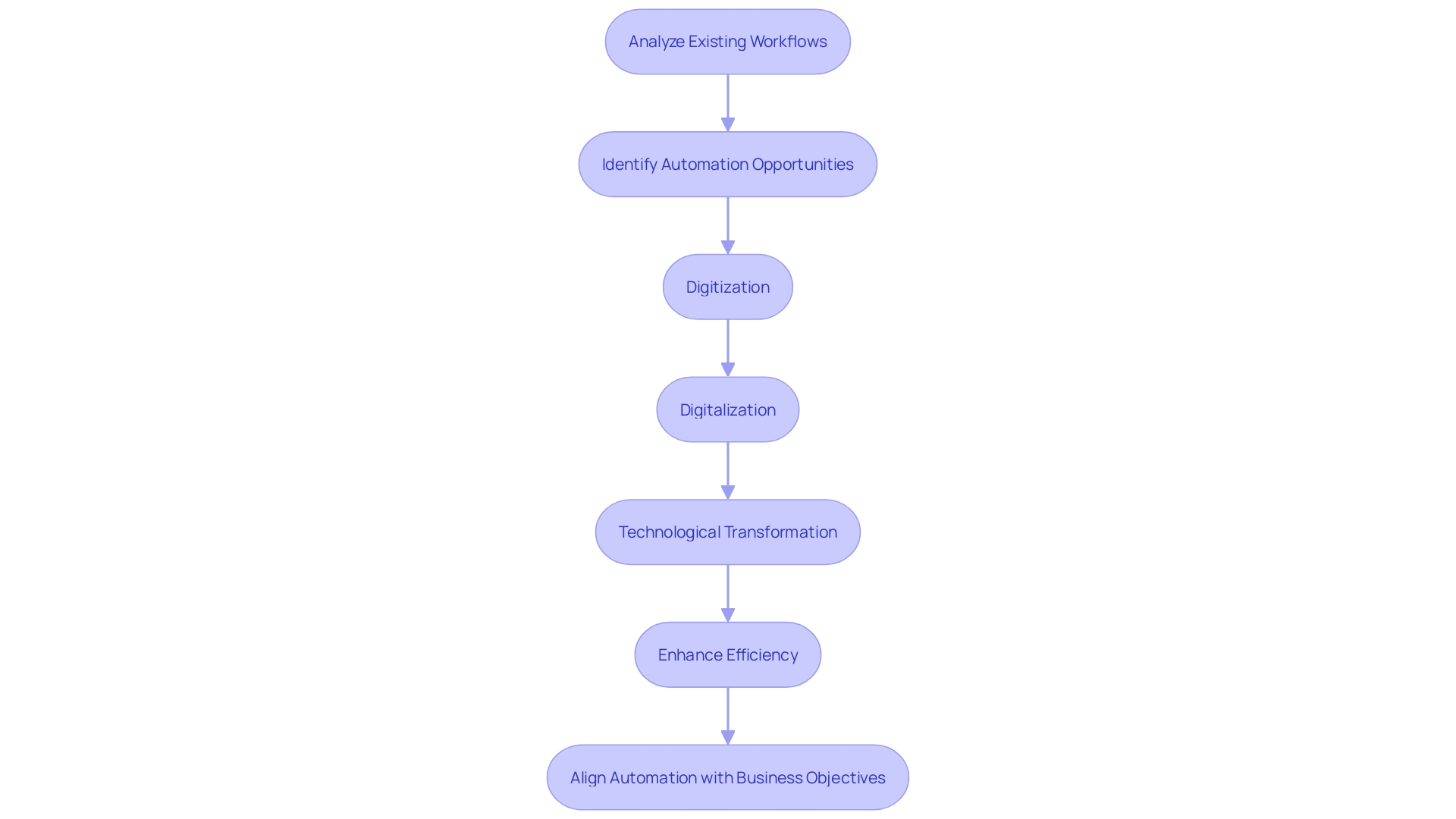
Map Out Clear Process Workflows and Automation Scenarios
Before implementing RPA, it is crucial to map out existing workflows meticulously. This procedure includes visualizing each step and identifying bottlenecks. By converting current information and files into a digital format, organizations can accurately depict their physical operations. Subsequently, digitalization alters these procedures and organizational frameworks to improve data capture, analysis, and information distribution. This comprehensive approach enables the development of clear robotic process scenarios, assisting organizations in comprehending how RPA can be incorporated into their wider operational framework. As technology becomes central to complete process execution, it enables employees to focus on high-value tasks, ultimately driving digital transformation and adding value across the supply network.
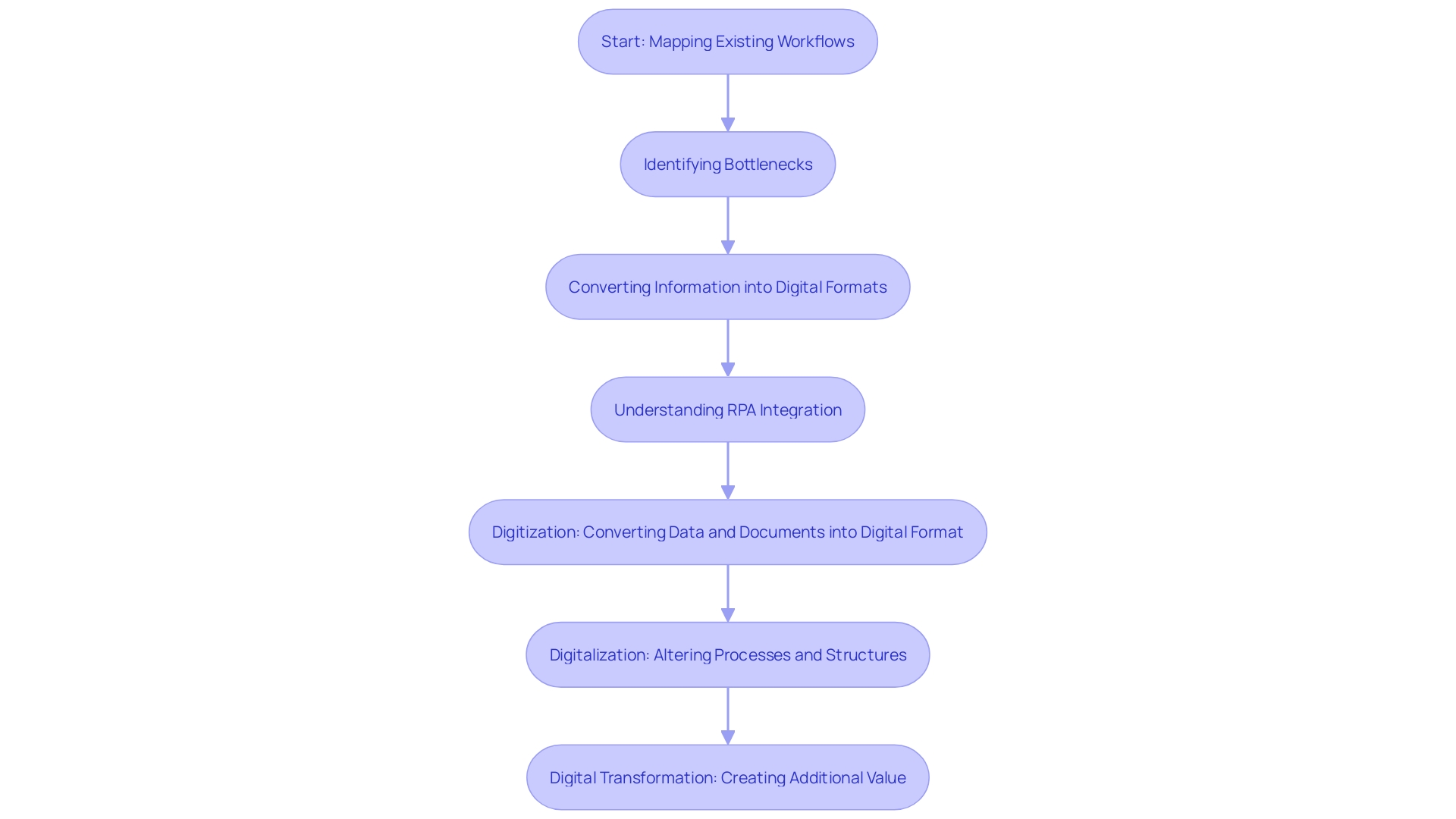
Develop a Roadmap for Scaling RPA Initiatives Across the Organization
A well-defined roadmap is essential for scaling RPA initiatives. This roadmap should encompass short-term and long-term goals, timelines, and resource allocation, providing a clear structure for phased implementation. By setting these parameters, organizations can methodically expand their RPA applications while accommodating necessary adjustments and optimizations along the way.
To start, it’s essential to measure and evaluate the quality of use cases for mechanization within the organization. This involves evaluating criteria such as the frequency of automated executions, potential monetary value derived, and anticipation of peak demand periods. For instance, calculating the time saved by automating a task compared to manual completion can offer significant insights into the potential return on investment (ROI). In the same way, comprehending the organization of electronic information used in operations aids in pinpointing regions with significant automation potential.
Moreover, adopting a dynamic approach to data management is vital. This means developing an organizational ontology, a comprehensive model defining entities and their interrelationships relevant to the business. This evolving framework allows for the adaptation to changing data requirements and goals, ensuring the organization remains agile in its RPA journey.
By positioning technology at the core of end-to-end execution, organizations can liberate human resources to concentrate on high-value tasks, thereby enhancing productivity and efficiency. The multi-stage process of digital transformation—comprising digitization, digitalization, and ultimately, digital transformation—supports this by leveraging improved data capture, analysis, and information dissemination. This approach not only meets current objectives but also anticipates future needs, fostering a resilient and forward-thinking operational environment.
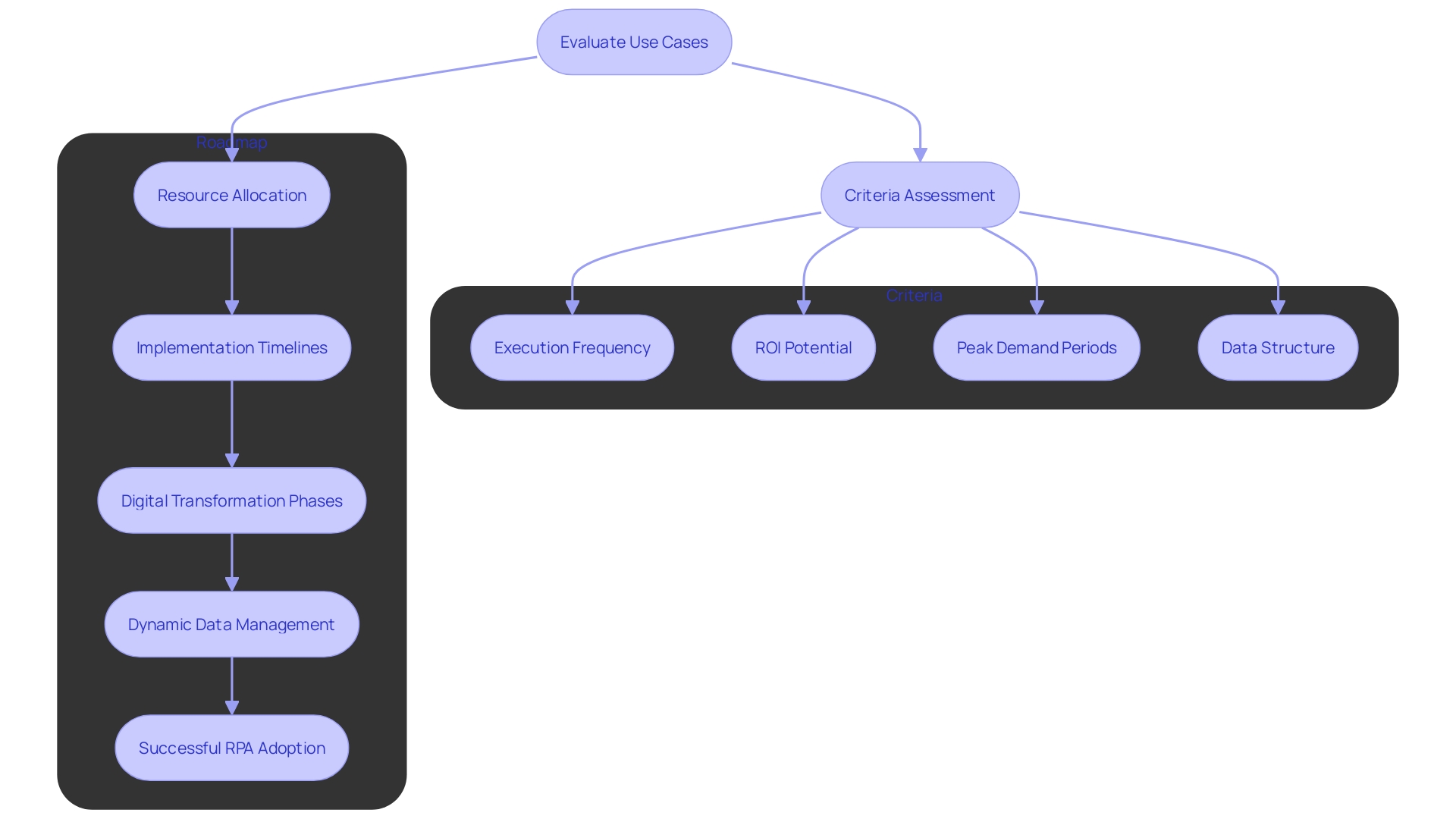
Create a Center of Excellence (CoE) for RPA Governance
Creating a Center of Excellence (CoE) for RPA governance guarantees that robotic process strategies are meticulously aligned with overarching business objectives. The CoE acts as a central hub for best practices, knowledge dissemination, and continuous support, fostering an environment where teams can effectively collaborate and drive a culture of relentless improvement.
The CoE is instrumental in creating principles, policies, and guardrails that govern the use of automated processes, ensuring alignment with the organization’s mission and values. This foundation facilitates the development of robust AI frameworks, such as the AI Risk Management Framework by NIST, providing clear operating structures and objectives. Additionally, integrating these frameworks with existing corporate governance structures prevents the creation of shadow risk functions and ensures that escalation paths and decision authority are clearly defined.
Furthermore, the CoE can recognize and promote high-impact initiatives, as shown by a large pharma company that utilized a central technological function to create ‘lighthouse projects.’ These projects serve as benchmark examples, promoting standardization and innovation across the company. This strategic approach ensures that mechanization initiatives are not just incremental but transformational, addressing core business challenges.
By concentrating on criteria such as the frequency of automated processes, potential monetary value, and the structure of digital data, the Code can evaluate the true significance of these processes for the enterprise. This meticulous evaluation helps quantify ROI and understand qualitative aspects of use cases, much like Tony Stark crafting a suit that enhances efficiency while aligning with core elements of significance.
In summary, a CoE for RPA governance is not just about maintaining standards; it’s about driving strategic alignment, fostering innovation, and ensuring that these efforts are impactful and aligned with business goals.
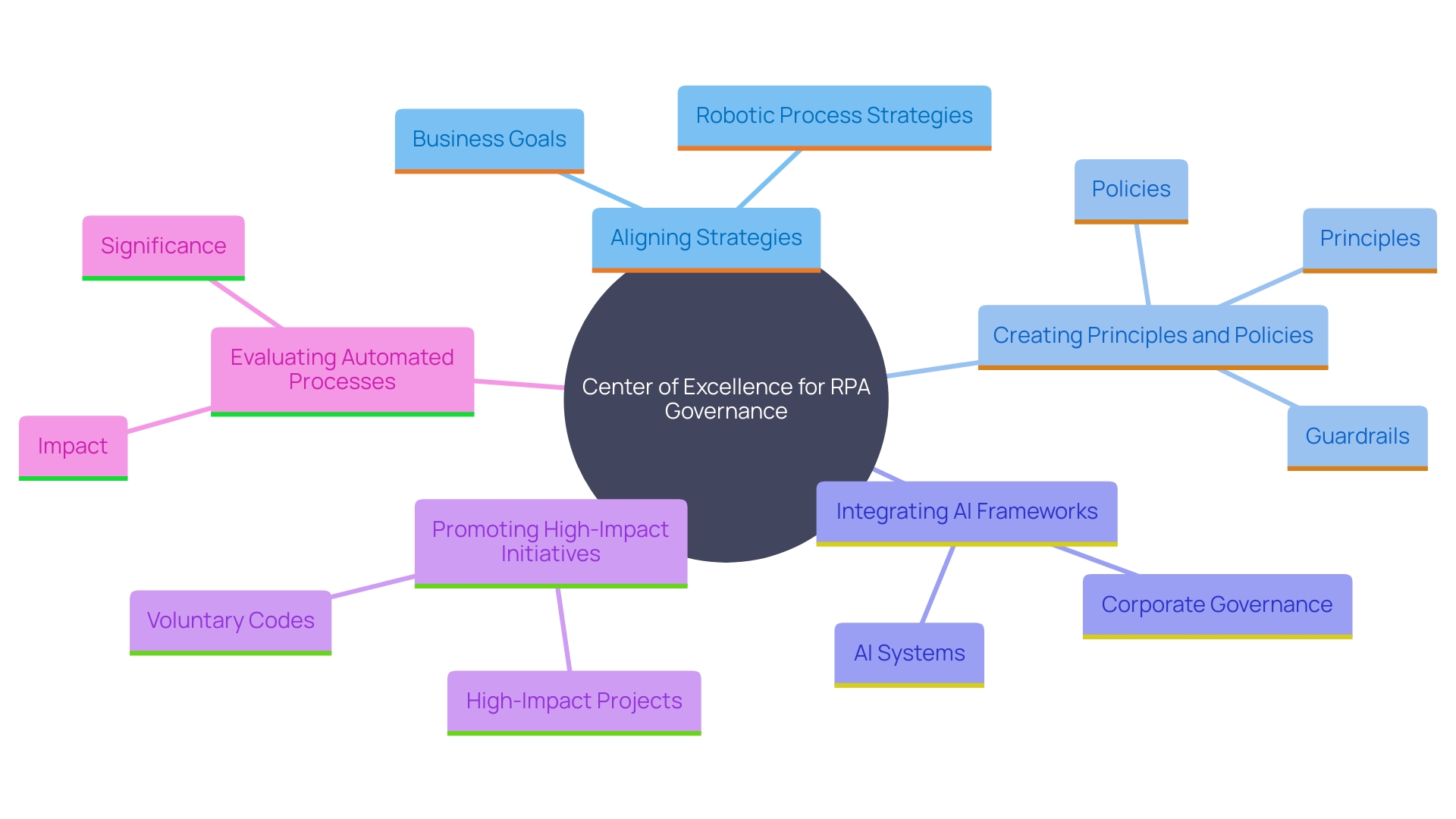
Measure Results and Document Lessons Learned
Implementing robust metrics to track the performance of RPA initiatives is essential for optimizing operations. By concentrating on efficiency improvements, cost reductions, and employee contentment, organizations can obtain valuable insights into the effectiveness of their mechanization strategies. This approach aligns with the comprehensive framework of digital transformation, which involves digitization, digitalization, and ultimately altering business operations to create additional value.
A prime illustration originates from the Surrey County Council, which has utilized technology to enhance both citizen and employee experiences. This initiative underscores the importance of placing technology at the center of end-to-end process execution, allowing human workers to focus on high-value tasks. Documenting lessons learned from such implementations not only helps to refine current practices but also serves as a critical resource for future RPA projects.
Moreover, organizations should clarify the business needs they aim to address with automation, such as reducing operating costs or enhancing productivity. Establishing guiding principles for technology selection and understanding trade-offs can significantly impact the success of RPA initiatives. With these strategies in place, companies can navigate the complexities of digital transformation more effectively.
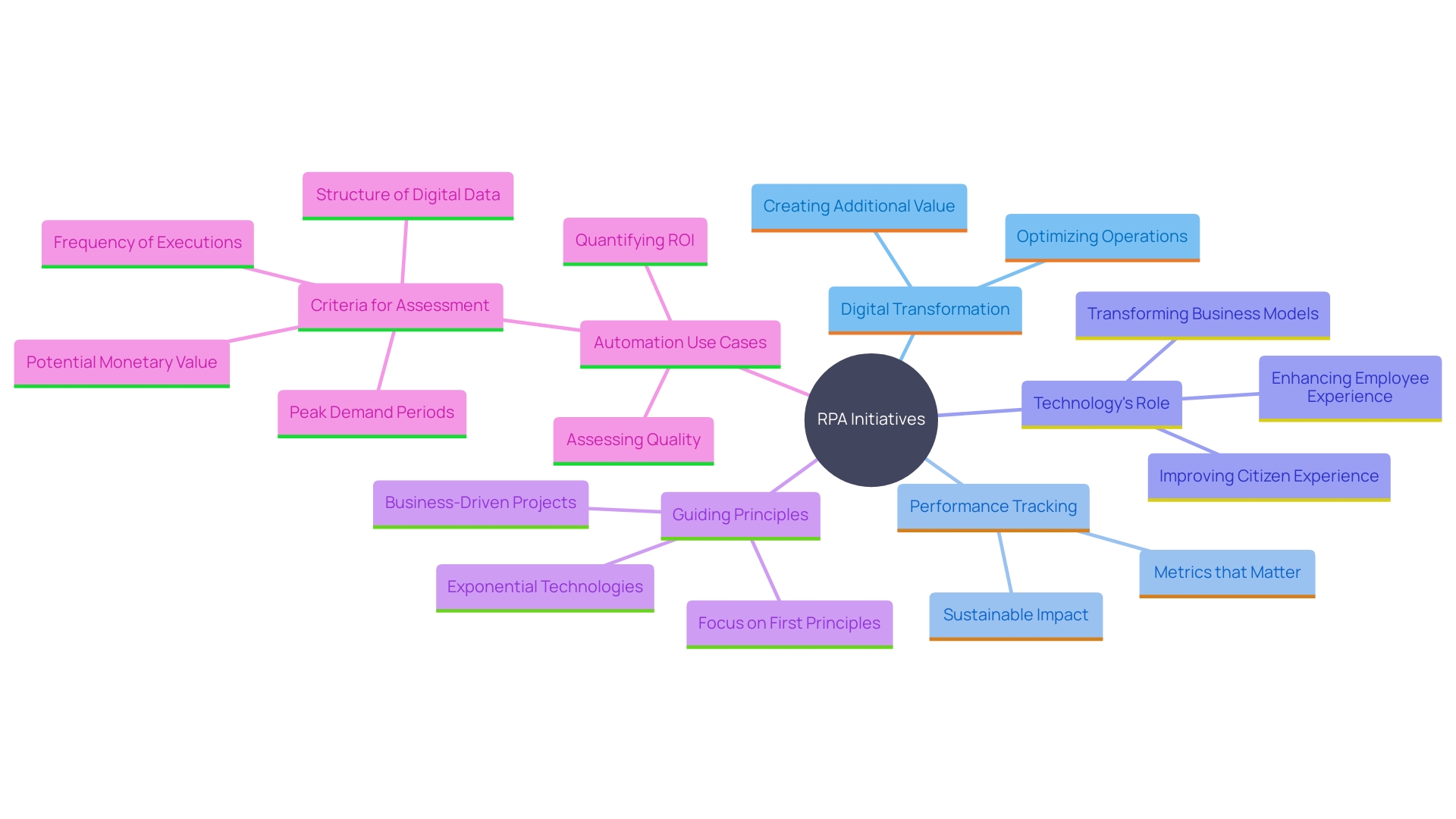
Conclusion
Harnessing Robotic Process Automation (RPA) presents a transformative opportunity for organizations aiming to enhance operational efficiency and streamline workflows. Understanding RPA’s capabilities and limitations is essential; while it excels in automating repetitive tasks, processes requiring human judgment should remain untouched. Identifying the right automation opportunities through comprehensive workflow analysis ensures alignment with business objectives, paving the way for significant efficiency gains.
Mapping out clear process workflows is critical for successful RPA implementation. This involves pinpointing bottlenecks and creating automation scenarios that seamlessly integrate into existing frameworks. A well-defined roadmap for scaling RPA initiatives not only outlines short- and long-term goals but also adapts to changing business needs, fostering an agile environment that prioritizes high-value tasks.
Establishing a Center of Excellence (CoE) for RPA governance solidifies the foundation for successful automation strategies. The CoE promotes best practices, drives innovation, and ensures that automation efforts align with overarching business goals. By measuring results and documenting lessons learned, organizations can refine their RPA initiatives, optimize performance, and ultimately contribute to a culture of continuous improvement.
In conclusion, the strategic deployment of RPA has the potential to significantly enhance productivity, accuracy, and operational excellence. By understanding its capabilities, identifying opportunities, and implementing structured governance, organizations can drive sustainable transformation and position themselves for long-term success in an increasingly digital landscape.

